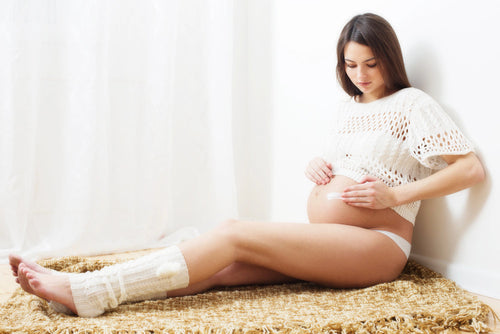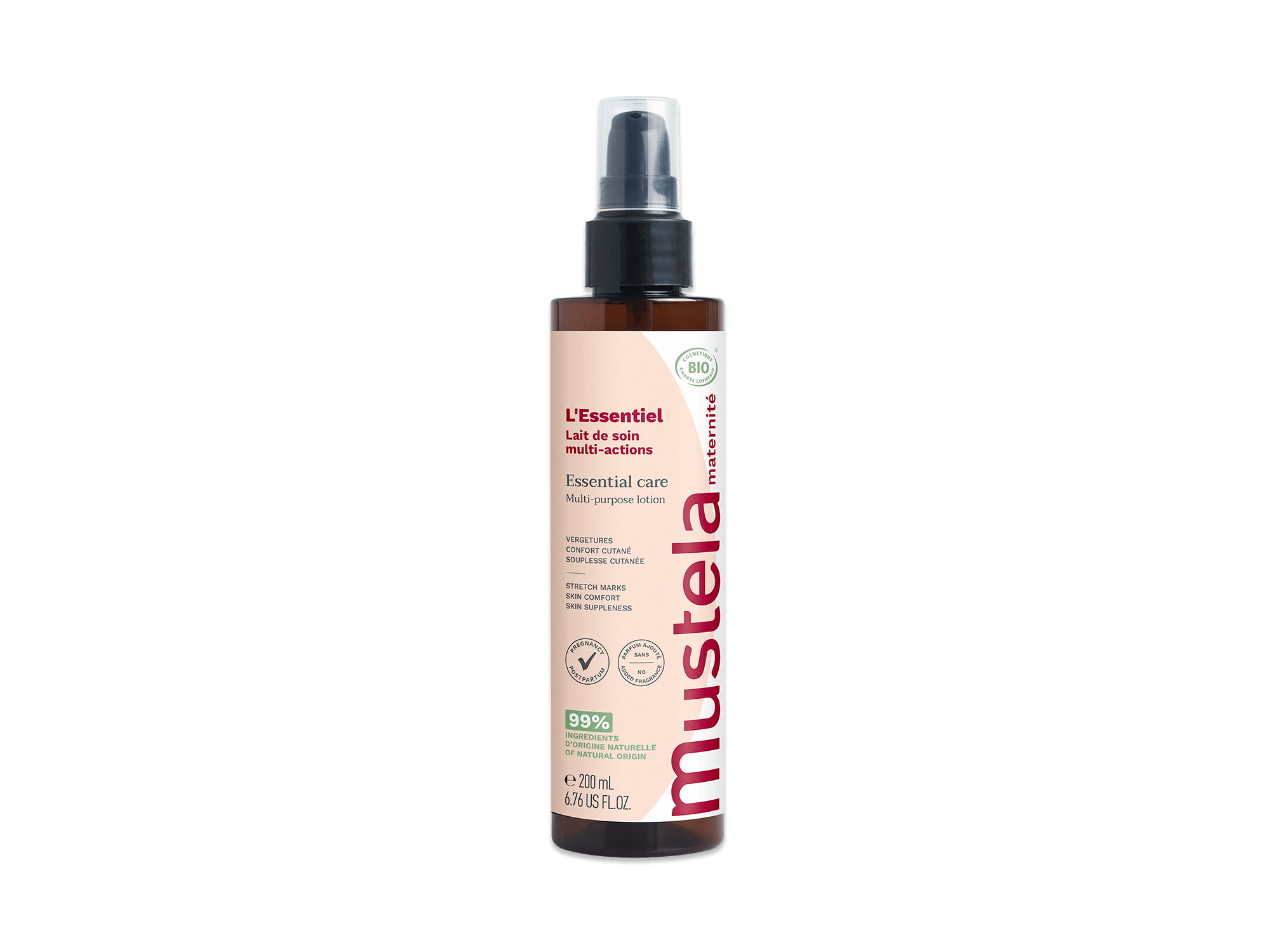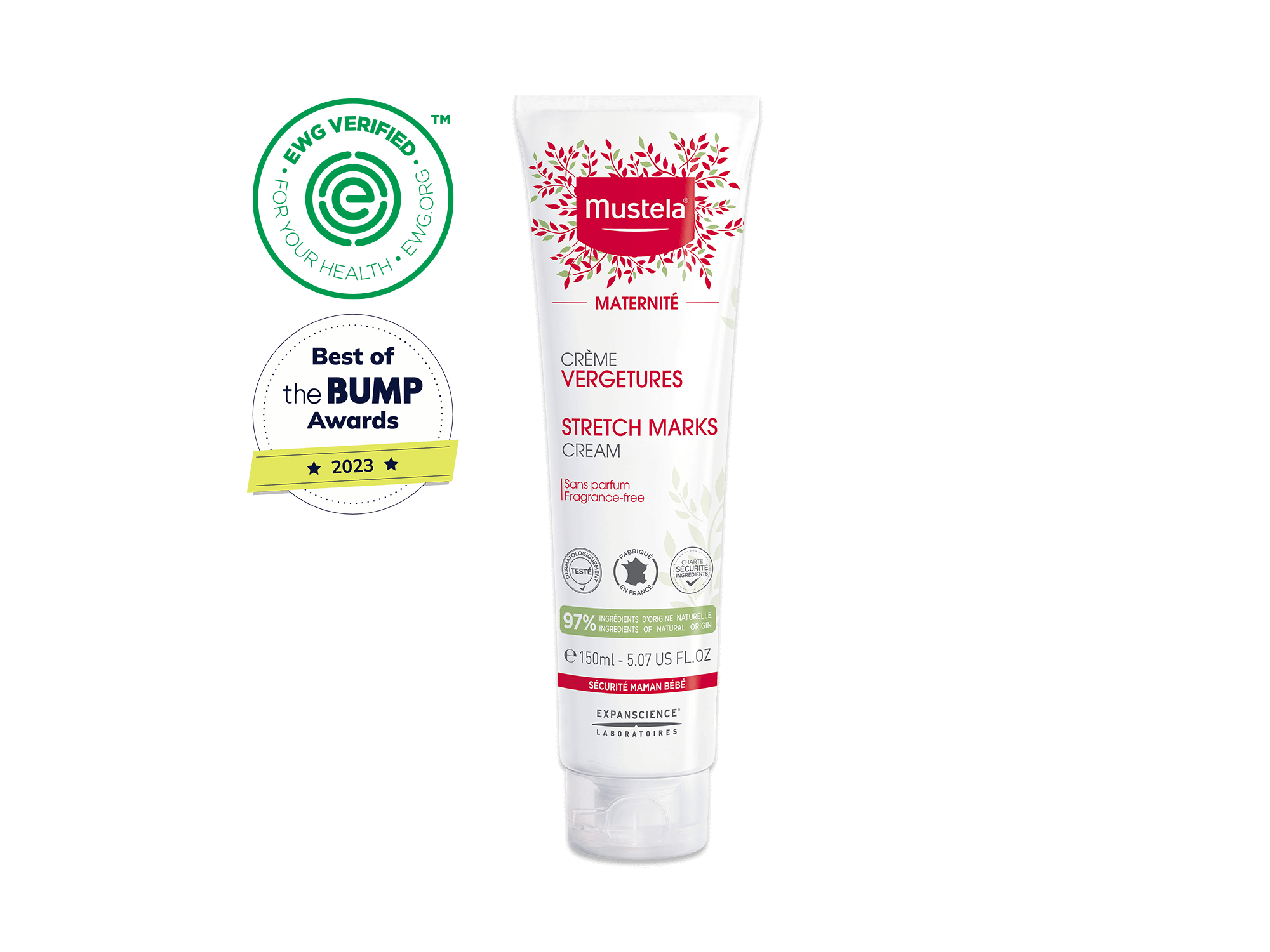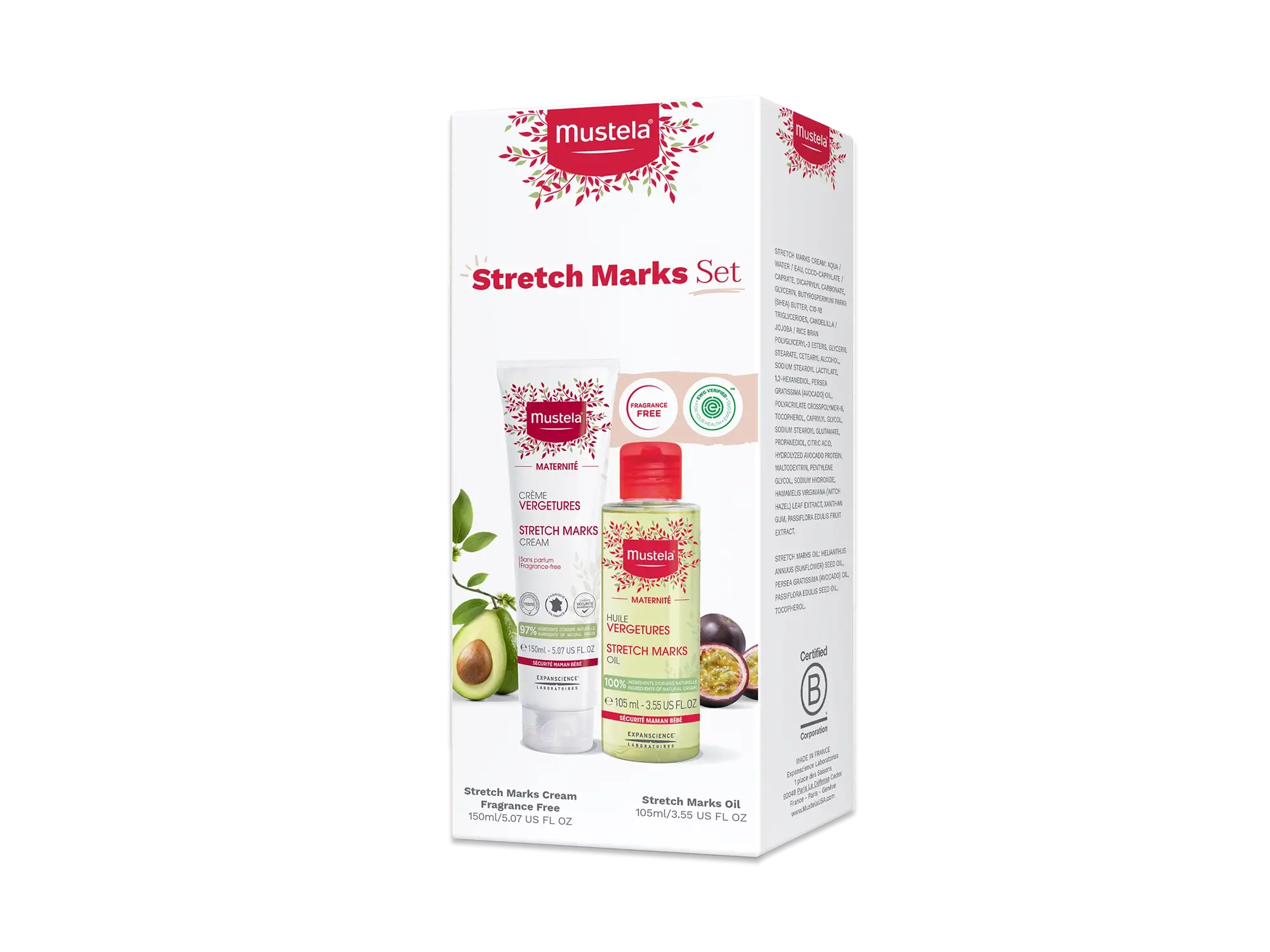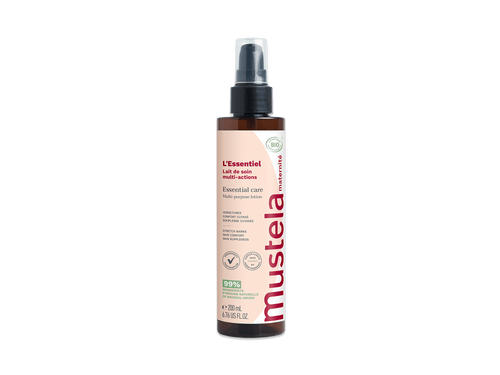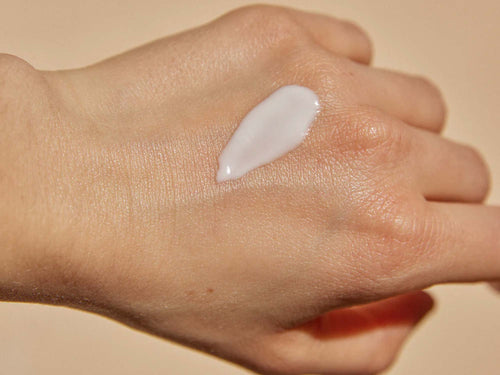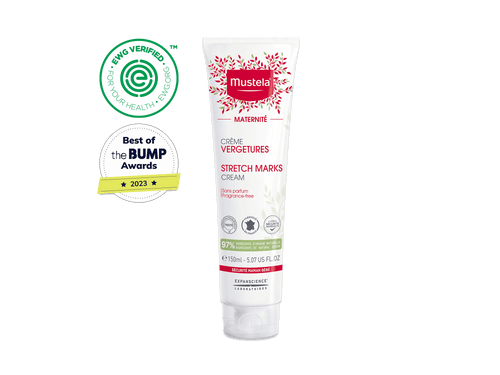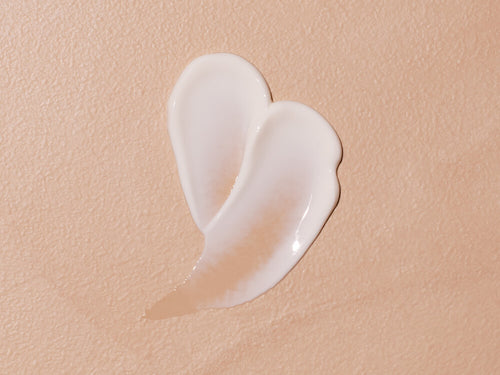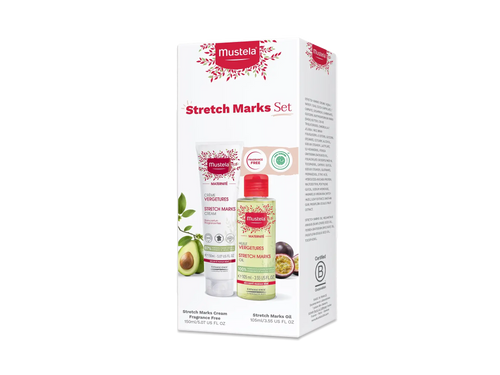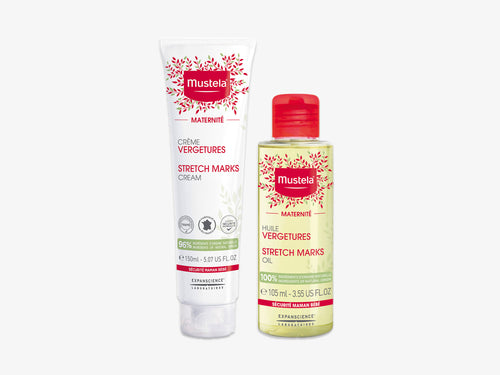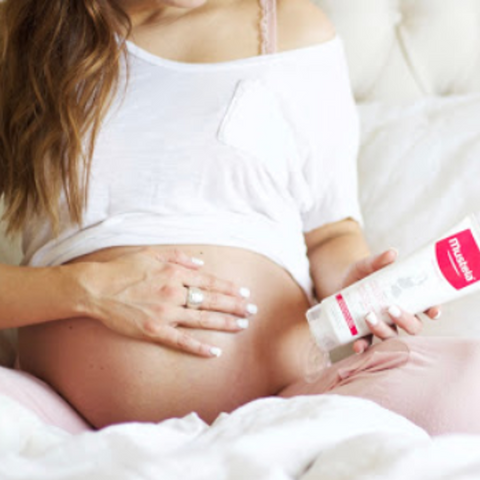Curious about stretch marks during pregnancy? In this article, we discuss the three types of stretch marks you can expect to see, what causes them, and how you can treat them when they appear.
Key Takeaways
- There are three types of stretch marks you can expect during pregnancy: Striae rubrae, striae albae, and striae gravidarum. Of the three, striae gravidarum occurs only during pregnancy, while the other two can occur at any time.
- The most common cause of stretch marks is rapid skin stretching. During pregnancy, this happens as your belly (and your baby) grows, but other causes include weight gain, hormones, genetics, your starting weight/BMI, the size of your baby, and your age.
- You can reduce the appearance of stretch marks during pregnancy by applying a specially formulated stretch marks cream, managing your weight gain, staying hydrated, eating a balanced diet, and massaging your stretch marks to break down the scar tissue.
Types Of Stretch Marks During Pregnancy

There are three main types of stretch marks that can occur during pregnancy: striae gravidarum, striae rubrae, and striae albae.
Striae Gravidarum
Striae gravidarum (a.k.a. striae distensae) refers specifically to the stretch marks that occur during pregnancy and may include the other two types of stretch marks mentioned here.
One of the most common striae gravidarum is the linea nigra that can form on the midline between the left and right sides of your abdomen.
Striae gravidarum most often appear on the abdomen, breasts, buttocks, thighs, and hips as your hormones change and your skin stretches to accommodate your growing baby.
These stretch marks may start out as raised red, purple, or brown lines that eventually flatten out and fade to silvery-white.
Striae Rubrae
Striae rubrae are the earliest form of stretch marks that can form during pregnancy and throughout your life. They often appear as raised reddish or purplish lines or streaks on your abdomen, breasts, thighs, buttocks, and hips.
The color is a result of blood vessels showing through small tears in the dermis as your skin stretches. Eventually, the color will fade and transition into striae albae.
Striae rubrae may feel itchy at first, but that irritation typically goes away. You can treat the itchiness by moisturizing your skin (more on later).
Striae Albae
Striae albae are mature stretch marks that appear as silvery-white or skin-toned lines on your abdomen, breasts, thighs, buttocks, and hips.
These stretch marks are basically tiny scars left from the rapid skin stretching that occurs during pregnancy. Because of this, striae albae can be more difficult to treat than striae rubrae.
Common Causes Of Stretch Marks During Pregnancy

Weight Gain
Weight gain is one of the most common causes of stretch marks during pregnancy. Think of this cause as broken into two sub-causes: 1) the amount of weight you gain, and 2) how fast you gain weight.
Some weight gain is perfectly normal, healthy, and necessary during pregnancy (you are nurturing a new life, after all!). But gaining a lot of weight, and doing so very quickly, increases your chance of developing stretch marks.
Rapid weight gain results in rapid skin stretching that your body can’t repair fast enough. This leads to tiny tears in your dermis that result in stretch marks.
Gradual, steady weight gain is better for both your overall health and the health of your skin. Talk to your doctor about what’s right for you and your baby.
Hormones
When you become pregnant, your body starts producing a lot of different hormones, including one called relaxin.
Relaxin helps your joints loosen up in preparation for childbirth, but some research suggests that it might also make the collagen and elastin in your skin weaker and less able to stretch without breaking.
This “stiffness” in your skin can make you more vulnerable to stretch marks during pregnancy.
Genetics
Genetics also play a major role in how well your skin stretches during pregnancy.
In particular, your genes determine how much collagen and elastin your skin has and how flexible those fibers are. The less flexible, the more likely you are to develop stretch marks as your belly grows.
Starting Weight
Some studies suggest that women who have a higher weight or body mass index (BMI) before getting pregnant may be more likely to develop stretch marks.
These same studies speculate that this is likely related to the fact that there’s more skin to stretch. Additionally, existing stretch marks may prevent the skin from continuing to stretch during pregnancy.
Baby’s Size
Carrying a larger baby (or twins or triplets) means that your belly will likely get bigger than it would if you were carrying a single smaller baby. Carrying a large baby or multiples also means that your belly may get bigger faster.
Both the size of your baby (or babies) and the rate at which your belly expands can lead to more prominent stretch marks.
Age
Age can also play a factor in whether or not you’ll develop stretch marks during pregnancy. Some evidence suggests that younger women are more prone to stretch marks because their skin is firmer and less elastic.
That’s not to say that older women won’t develop stretch marks, just that their skin might be better able to stretch without tearing as their bodies grow to nurture their babies.
How To Treat Stretch Marks During Pregnancy
Preventing stretch marks completely is pretty much impossible. You can, however, adopt a skincare routine that helps minimize the appearance of the ones that do develop.
Here’s how.
Apply A Stretch Marks Cream Or Oil
Stretch marks creams and oils are a great way to improve or maintain the texture and hydration of your skin so that it can stretch without tearing as your baby grows.
Look for ingredients such as:
- Sunflower seed oil
- Avocado oil
- Avocado protein
- Passionfruit oil
- Glycerin
- Shea butter
- Jojoba
For best results, follow the directions on the package. As a general rule, that will include applying the cream or oil to your abdomen, hips, thighs, and breasts in the morning and before bed.
Stay Hydrated
Drinking plenty of water throughout the day is one of the best ways to keep your skin well-hydrated from the inside out. Aim for 8 to 12 cups (64 to 96 ounces) every day to give your skin the suppleness and elasticity it needs during pregnancy.
Manage Weight Gain
As we’ve mentioned, excessive weight gain (or weight put on too fast) can put stress on your skin and cause stretch marks during pregnancy.
Talk to your doctor about what healthy weight gain looks like for you, and do your best to follow their recommendations.
Eat A Balanced Diet
A big part of managing your weight gain involves eating a balanced diet. This includes plenty of fruits, vegetables, protein, and other foods that contain vitamin C, vitamin D, vitamin E, and zinc.
Talk to your OB/GYN about the right diet for you.
Massage Your Stretch Marks
As we mentioned, initial stretch marks (i.e., striae rubrae or striae gravidarum) are small tears in the dermis of your skin that eventually turn into tiny scars (striae albae).
One way to treat both of those types of stretch marks during pregnancy is to massage the affected areas with a moisturizing cream or oil (specialized stretch marks creams and oils work well, too).
A gentle massage can help increase blood flow and elasticity in your skin. Plus, massaging your belly is a wonderful way to connect with your unborn baby!
Hydrate Your Skin With Mustela!

Want a hard-working cream or oil specifically formulated to deliver hydration directly to the areas where stretch marks are likely to form? Try Mustela’s Stretch Marks Cream and Stretch Marks Oil.
Both products nourish and moisturize skin, leaving it soft, supple, flexible, and better able as your belly grows.
Frequently Asked Questions
Are stretch marks harmful?
Stretch marks aren’t harmful and don’t cause or lead to any medical problems. In addition, stretch marks don’t typically hurt in any way. They may be itchy as they develop, but that itchiness usually fades over time.
Can I prevent stretch marks during pregnancy?
Unfortunately, there’s no guaranteed way to completely prevent stretch marks, especially during pregnancy.
That said, you can do things to reduce the appearance of stretch marks during pregnancy (and throughout your life) by maintaining healthy weight gain, staying hydrated, and keeping your skin moisturized.
Do stretch marks ever go away?
In general, stretch marks don’t go away completely. They may fade over time after pregnancy, but they seldom fully disappear.
The important thing to remember is that stretch marks are a very common and normal part of pregnancy. Instead of trying to get rid of them, many people choose to embrace them as a mark of pride for bringing a new life into the world.



